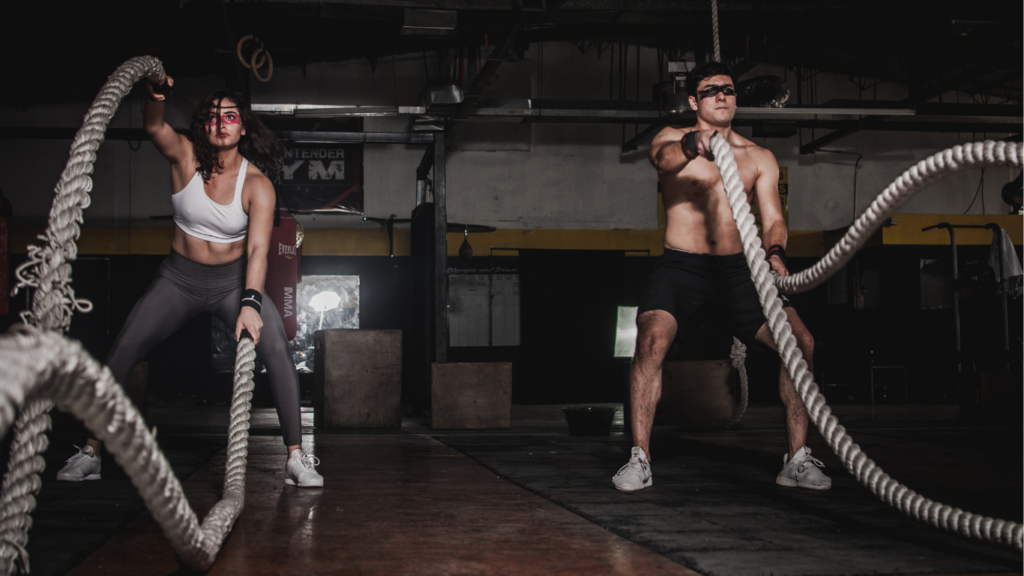Understanding HIIT and Steady-State Cardio
High-Intensity Interval Training (HIIT) and steady-state cardio are two distinct cardio approaches, each with unique features and benefits. Exploring these methods helps clarify their suitability for different fitness objectives.
What is HIIT?
HIIT involves short, intense bursts of exercise followed by recovery periods. These sessions often last 20-30 minutes but deliver a high calorie burn and improved aerobic capacity. A typical HIIT workout might include sprinting for 30 seconds followed by a minute of walking. This technique boosts metabolism and improves cardiovascular health, making it ideal for those seeking quick results within restricted timeframes.
What is Steady-State Cardio?
Steady-state cardio consists of maintaining a consistent, moderate level of exertion over a prolonged period. Activities like:
- jogging
- cycling
- swimming
for 30-60 minutes fall into this category. This approach builds endurance and aerobic capacity while offering a lower risk of injury compared to more vigorous exercises. As steady-state sessions typically feel less intense, they’re perfect for individuals who enjoy longer, more relaxed workouts.
Benefits of HIIT
High-Intensity Interval Training (HIIT) offers distinct advantages that make it a popular choice for many fitness enthusiasts. Its dynamic nature and adaptable sessions cater to various fitness goals efficiently.
Time Efficiency
HIIT condenses effective workouts into short durations. Sessions typically last 20-30 minutes, making them ideal for those with busy schedules. This approach allows for fitting exercise into daily routines without sacrificing results.
Improved Metabolic Rate
HIIT increases the metabolic rate significantly. The intensity of the workouts boosts calorie burn even after the exercise session ends. This effect, known as excess post-exercise oxygen consumption (EPOC), means more calories burned long after the workout is finished.
Cardiovascular Health
HIIT enhances cardiovascular health by effectively challenging the heart and lungs. Regular sessions improve aerobic capacity and heart function, providing benefits similar to traditional cardio but in less time. This aspect makes HIIT appealing for improving overall heart health efficiently.
Benefits of Steady-State Cardio
Steady-state cardio focuses on maintaining a consistent pace, offering unique advantages for overall fitness and well-being through prolonged workouts.
Endurance Building
- Endurance builds effectively with steady-state cardio.
- When engaging in activities like jogging or cycling consistently over periods of 30-60 minutes, the cardiovascular system strengthens progressively.
- Over time, this approach enhances aerobic capacity and increases stamina, making it ideal for those looking to improve their overall endurance levels.
Stress Reduction
- Stress reduces significantly during uninterrupted, moderate exercise.
- The rhythmic nature of steady-state cardio promotes relaxation and mental clarity.
- Regular participation can lead to the release of endorphins, which are natural mood elevators, and help diminish anxiety or stress, contributing positively to mental health.
Consistency and Injury Prevention
- Consistency thrives when workouts are sustainable.
- Steady-state cardio’s moderate intensity allows for longer durations without overwhelming the body, making it easier to establish a regular exercise routine.
- This method also inherently carries a lower risk of injury compared to high-impact activities, providing a safer option for those new to exercise or returning after a hiatus.
Comparing HIIT and Steady-State Cardio

Both HIIT and steady-state cardio offer unique advantages for various fitness goals. Understanding their differences helps determine which aligns better with individual needs.
Calorie Burn and Weight Loss
HIIT sessions, with their high-intensity bursts, burn more calories in a shorter time compared to steady-state cardio. This intensity not only reduces workout duration but also ensures continued calorie burn post-exercise due to EPOC. For weight loss, this afterburn effect makes HIIT particularly effective when time constraints exist.
Steady-state cardio, though burning fewer calories during exercise, aids weight loss over time through consistent calorie expenditure. Its moderate pace suits those needing a gradual approach, making it a reliable option for sustained weight loss progress.
Impact on Muscle Mass
HIIT maintains and can even build muscle mass due to its explosive exercises that challenge muscle fibers. These workouts, integrating strength components, prevent muscle loss typical in prolonged cardio sessions. This makes HIIT favorable for maintaining a toned physique while cutting fat.
In contrast, steady-state cardio offers minimal muscle-building potential, emphasizing endurance over strength. If muscle preservation is a priority, balancing it with resistance training becomes necessary to mitigate muscle loss from long-duration sessions.
Suitability for Beginners and Advanced Athletes
HIIT’s intense nature may overwhelm beginners, potentially leading to injury without proper conditioning or supervision. Gradually incorporating it when building foundational fitness allows less experienced individuals to reap its benefits.
Steady-state cardio, with its lower intensity, provides a safer entry point for novices. Its approachable pace accommodates gradual progress, making it ideal for integrating into early fitness routines. Advanced athletes can still find value in steady-state sessions for active recovery and endurance enhancement.
Choosing the Right Workout for You
Selecting between HIIT and steady-state cardio often hinges on individual objectives and circumstances. Understanding personal goals and fitness levels, and combining both workouts effectively, can guide you toward the optimal routine.
Considerations for Personal Goals
Personal goals greatly influence workout choices. If rapid weight loss or improving anaerobic capacity is a priority, HIIT might be attractive due to its intense, short bursts that torch calories and boost metabolism. Those aiming for endurance, stress relief, or consistent calorie burn may lean toward steady-state cardio’s sustained, moderate sessions that improve stamina and mental clarity.
Assessing Fitness Levels
Fitness level assessment helps tailor workout intensity. Beginners or individuals returning to exercise might find steady-state cardio offers a safer, less intense entry with reduced injury risk. Advanced individuals or those accustomed to high-intensity training could benefit from the challenging yet rewarding HIIT sessions that push boundaries and aid muscle retention.
Balancing Both in a Fitness Routine
Integrating both HIIT and steady-state cardio achieves a well-rounded fitness regimen. Incorporating HIIT can maximize calorie burn and improve cardiovascular health in limited time, while steady-state cardio supports endurance building and active recovery. Alternating between these methods ensures varied workouts cater to dynamic fitness goals and prevent monotony.



 Senior Sports Writer
Alfred Alder is the senior sports writer at Sprint Scoop News, bringing his extensive knowledge of fitness, training, and sports business to the forefront. With a career spanning more than a decade, Alfred specializes in delivering high-quality, engaging content that covers everything from sponsorship trends to the latest in health and nutrition for athletes. His deep understanding of the sports industry allows him to provide readers with comprehensive insights that make complex topics accessible and exciting.
Senior Sports Writer
Alfred Alder is the senior sports writer at Sprint Scoop News, bringing his extensive knowledge of fitness, training, and sports business to the forefront. With a career spanning more than a decade, Alfred specializes in delivering high-quality, engaging content that covers everything from sponsorship trends to the latest in health and nutrition for athletes. His deep understanding of the sports industry allows him to provide readers with comprehensive insights that make complex topics accessible and exciting.
